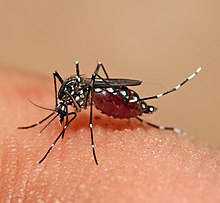| Aedini | |
|---|---|
 | |
| Aedes aegypti | |
| Scientific classification | |
| Domain: | Eukaryota |
| Kingdom: | Animalia |
| Phylum: | Arthropoda |
| Class: | Insecta |
| Order: | Diptera |
| Family: | Culicidae |
| Subfamily: | Culicinae |
| Tribe: | Aedini Neveu-Lemaire, 1902 |
| Type genus | |
| Aedes Meigen, 1818 | |
| Genera | |
See text | |
| Synonyms | |
| |
Aedini is a mosquito tribe in the subfamily Culicinae. It is the main tribe of mosquitoes with 1256 species classified in 81 genera and two groups incertae sedis.